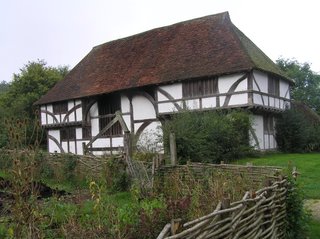
These are just sundry images that I took around the Weald and Downland Open Air Museum where I did the courses I've written about.There is no particular theme or order to them, they are simply things that appealed to me. The photograph at the top is of Bayleaf Farmhouse which is probably the most famous of the buildings at the museum. It's the only thing that has a separate guide book all to itself. It's 15th century and has replica furnishings and a garden from the period. The garden was designed by Sylvia Landsberger and is as authentic as it could be made.
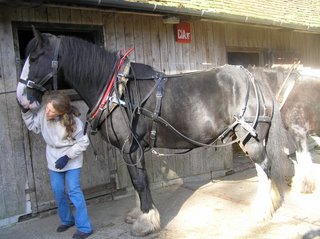 This is Neville, one of the Shire horses who live and work at the museum. They are used for ploughing, carting, haymaking and all the other farm tasks that they would have done when horses were used for everything. The museum also has a pair of oxen which are used as well but they weren't around to be photographed while I was there. I love all the big working horses and Neville is particularly patient and friendly.
This is Neville, one of the Shire horses who live and work at the museum. They are used for ploughing, carting, haymaking and all the other farm tasks that they would have done when horses were used for everything. The museum also has a pair of oxen which are used as well but they weren't around to be photographed while I was there. I love all the big working horses and Neville is particularly patient and friendly.  This is one of the Southdown sheep, this breed is native to the Sussex Downland country and produces very fine meat and wool, they are also very attractive and friendly, this one was very keen to speak to me!
This is one of the Southdown sheep, this breed is native to the Sussex Downland country and produces very fine meat and wool, they are also very attractive and friendly, this one was very keen to speak to me! The calf is a Sussex and again a native breed to this county. They were originally used as plough oxen rather than for meat only being slaughtered when they were too old for work. A full grown animal is very powerful but when young they are simply pretty and very shy.
The calf is a Sussex and again a native breed to this county. They were originally used as plough oxen rather than for meat only being slaughtered when they were too old for work. A full grown animal is very powerful but when young they are simply pretty and very shy.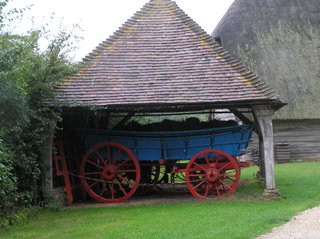 This is an 18th century waggon shed, I absolutely love these old farm waggons, I find the curved line so pleasing to my eye and I could stand and just look at them for hours.
This is an 18th century waggon shed, I absolutely love these old farm waggons, I find the curved line so pleasing to my eye and I could stand and just look at them for hours.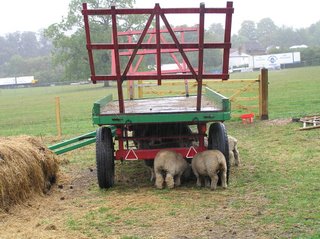 Southdown sheep sheltering from the rain under another of the lovely old pieces of farm equipment. It was pouring down at this point.
Southdown sheep sheltering from the rain under another of the lovely old pieces of farm equipment. It was pouring down at this point. Walderton, a 17th century brick and flint cottage with medieval origins.
Walderton, a 17th century brick and flint cottage with medieval origins.  Boarhunt is a 15th century hall house ie one large central hall open to the ceiling with a couple of bays at each side,one an inner room and the other used for storage. The hall would have had a fire in the centre which would have been used for both heat and cooking. No chimney, the smoke made its way out through the windows and the roof. Pretty to look at, pretty uncomfortable to live in I should think!
Boarhunt is a 15th century hall house ie one large central hall open to the ceiling with a couple of bays at each side,one an inner room and the other used for storage. The hall would have had a fire in the centre which would have been used for both heat and cooking. No chimney, the smoke made its way out through the windows and the roof. Pretty to look at, pretty uncomfortable to live in I should think! This is a lovely wild flower that you see everywhere in this part of England, it's a type of wild clematis with lovely country names the most common of which are old man's beard and traveller's joy. It was so beautiful I had to have a photograph of it.
This is a lovely wild flower that you see everywhere in this part of England, it's a type of wild clematis with lovely country names the most common of which are old man's beard and traveller's joy. It was so beautiful I had to have a photograph of it.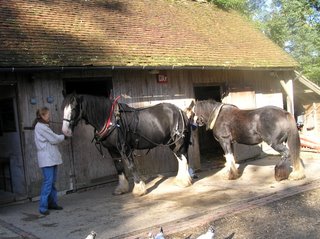 Back at the stables - Neville and friend again.
Back at the stables - Neville and friend again.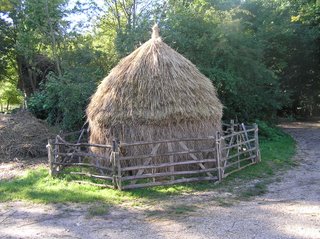 Another nostalgia trip for me - a small haystack, something you never see in this coutry any more and so much more attractive to look at than a field full of black plastic rolls. They do still have them in Romania, I saw them in the Carpathians when I was there, it was like stepping back a hundred years, the hay was cut by men using scythes and little old ladies dressed in black were raking it up with wooden hay rakes. However I digress!
Another nostalgia trip for me - a small haystack, something you never see in this coutry any more and so much more attractive to look at than a field full of black plastic rolls. They do still have them in Romania, I saw them in the Carpathians when I was there, it was like stepping back a hundred years, the hay was cut by men using scythes and little old ladies dressed in black were raking it up with wooden hay rakes. However I digress!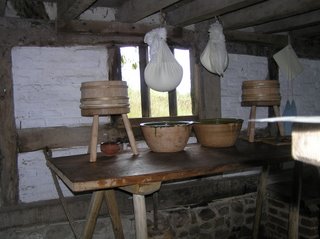 This is the dairy in Pendean cottage, the volunteers had been making cheese and it is hanging up to drip overnight seperating the curds and the whey.I'm hoping to do a dairying day course next summer, the idea of buttermaking especially appeals to me.
This is the dairy in Pendean cottage, the volunteers had been making cheese and it is hanging up to drip overnight seperating the curds and the whey.I'm hoping to do a dairying day course next summer, the idea of buttermaking especially appeals to me. A Tamnworth boar, the old cottagers pig. They are my favourite breed mostly because I love the rich chestnut colour. Alas, this particular one is no more, all that remains is a selection of bacon, hams and sausages!There are other Tamworths at the Museum who will make it through the winter though.
A Tamnworth boar, the old cottagers pig. They are my favourite breed mostly because I love the rich chestnut colour. Alas, this particular one is no more, all that remains is a selection of bacon, hams and sausages!There are other Tamworths at the Museum who will make it through the winter though. This is a granary from the early 1700s, I love this building, the lovely mellow colour of the bricks, the thatched roof, the staddle stones that support it - there is something totally satisfying about the whole thing.
This is a granary from the early 1700s, I love this building, the lovely mellow colour of the bricks, the thatched roof, the staddle stones that support it - there is something totally satisfying about the whole thing.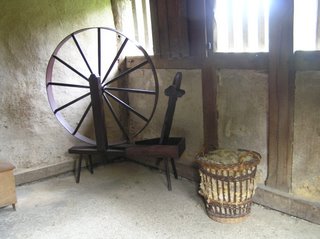 This is a walking wheel that stands in one of the bedrooms in Bayleaf. It must have been tiring work to spin on this. I'm not a spinner so I don't know exactly how it is used but the name indicates considerable input of energy! Even though it is displayed upstairs I imagine it would really have been kept in the living area downstairs so that the lady of the house could spin whenever she had some spare time while waiting for food to cook etc.
This is a walking wheel that stands in one of the bedrooms in Bayleaf. It must have been tiring work to spin on this. I'm not a spinner so I don't know exactly how it is used but the name indicates considerable input of energy! Even though it is displayed upstairs I imagine it would really have been kept in the living area downstairs so that the lady of the house could spin whenever she had some spare time while waiting for food to cook etc.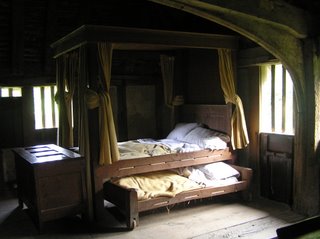 This is the same room showing the truckle bed and a storage chest where clothes would have been kept. The bed had mum and dad in the main bed and assorted children in the pull out truckle.
This is the same room showing the truckle bed and a storage chest where clothes would have been kept. The bed had mum and dad in the main bed and assorted children in the pull out truckle. Another view of the medieval garden at Bayleaf. I'd love to have a garden like this.
Another view of the medieval garden at Bayleaf. I'd love to have a garden like this. More representatives of the livestock, these I think are Light Sussex and Dorking hens, both traditional breeds. I like hens, their clucking and sqawking is somehow a very comforting sound. If anyone ever has chance to visit the Weald and Downland Museum it is well worth going, it's interesting for both adults and children and is set in beautiful surroundings. The courses they offer are very wide-ranging and open to anyone who wants to take them. The ones I've done have all been connected with herbs and cookery but there are also crafts, traditional building techniques, learning to plough with heavy horses, bee-keeping and more besides. You can learn to make your own longbow, carve a Green man, do blacksmithing, there are drawing and painting classes - the list is endless.
More representatives of the livestock, these I think are Light Sussex and Dorking hens, both traditional breeds. I like hens, their clucking and sqawking is somehow a very comforting sound. If anyone ever has chance to visit the Weald and Downland Museum it is well worth going, it's interesting for both adults and children and is set in beautiful surroundings. The courses they offer are very wide-ranging and open to anyone who wants to take them. The ones I've done have all been connected with herbs and cookery but there are also crafts, traditional building techniques, learning to plough with heavy horses, bee-keeping and more besides. You can learn to make your own longbow, carve a Green man, do blacksmithing, there are drawing and painting classes - the list is endless.








10 comments:
Another lovely virtual visit to a beautiful place courtesy of you and your camera. Thank you so much.
I love the chickens and all the varieties that are available. Also the pig in his sty, my mother had a fondness for them too. I honestly think if I had to provide my own meat, rather than purchase it from the butcher, I would be vegetarian. I would have given all these animals names and could never have eaten any of them. It's so admirable that these buildings are kept as they were in their 'day', and that future generations will not lose touch with an important part of their history.My ancestors were ag.labs. and I can only imagine how hard they worked, men and women, to keep body and soul together.
I agree with Shiela, LOL! I would have made pets of all those lovely animals. What wonderful pictures! Thank you for sharing them!
What a lovely visit, thank you! (I would have to each a lot of cheese and eggs and my hens would die of old age if it were left to me!)
Rowan I so enjoy your Blog! I'm glad I found it!
(Sheila, I just realized that I spelled your name wrong in my previous comment. I'm SO sorry!)
Rowan,
Your skill with the camera is quite good. I never tire of looking at the photos of your excursions back in time. Of course they stimulate a romanticized idea of the bucolic life which is comfortable for me. The realization of the "hardships" of that former lifestyle compared with today is shunted aside for a time.
Still, I think I might be content to relive that life, at least for awhile.
The pic if the wild clematis reminds me of the feather boas worn during the Victorian and Edwardian eras. I believe they were also popular with the flappers of the '20s.
The animals remind me of a period of time when we first moved to our present location. In an attempt to teach my children the realities of where our food comes from, we took to raising chickens and rabbits for eggs and meat. We established and maintained a huge vegetable garden. The produce was canned, frozen, and/or dried. Although we weren't able to raise all of our food we did a fair amount. Remember we were living in the village on a 1/5 acre lot. Unlike some citified folk, our children never said when asked, "where does milk come from?"..."the store."
Enough rambling. Thanks again for taking me with you on your trip, I enjoyed it immensely.
rel
Another wonderful trip ... I love the haystack, the wild clematis, and the beautiful thatched cottages but I agree that they were probably more adorably quaint than comfortable.
ooooooooooooooooooooh - another friend...this museum looks extensive and fun...I think I would love to visit this place...of course, first I would have to get there...we have a similar type of museum near us although it is not nearly so extensive...if you like looking at that sort of thing, it is here:
http://www.pbase.com/marybell/prairie
How charming.
My love of Britain has grown immensely after my days at Lindisfarne and in Newcastle. I will come back, and back, and back :-)
I enjoyed these photos too. I know that lamb is popular in the UK but here in the usa we eat very little.
Another great tour courtesy of Rowan! I love these little virtual excursions. I think you have a good eye with your camera and your words just bring things to life. I always come away with a satisfied feeling as if I've actually been to all these wonderful places.
Post a Comment